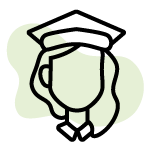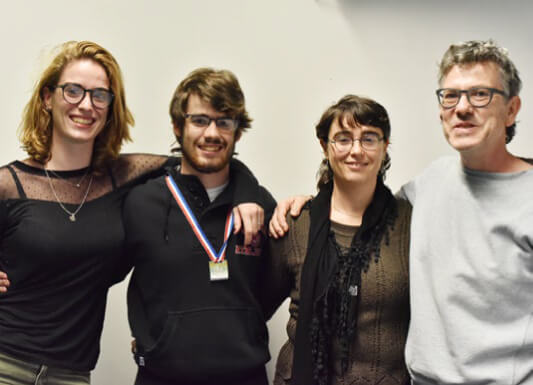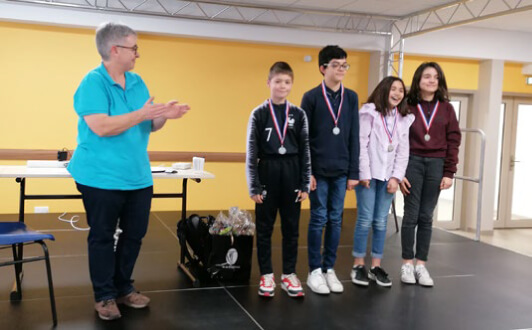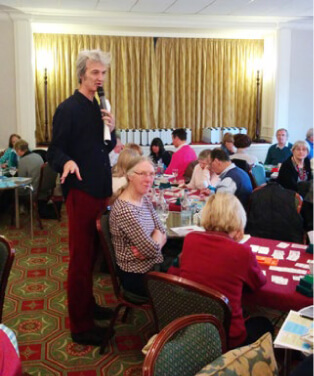
Teaching, a real job

Introducing friends or family to bridge is the best way to find new partners. It takes patience, pedagogy, method. In short, it’s real
work. How do teachers pass on technique and passion?
Share the passion
“Bridge is a rather difficult subject to transmit because you need a great capacity for synthesis.”
Pierre Dufrêne.
It’s 6 pm, Catherine Groprete-Govignon turns on her webcam. Then, her three young students come online. The small group is delighted to meet up for this weekly course of the Templiers de Coulommiers bridge-club. Even though they are separated by computer screens, the atmosphere is good, relaxed. After a few warm exchanges, Catherine questions her students, without pushing them around. In civilian life, Catherine is a German teacher. Pedagogy is her thing. She is a follower of the “snail method”
which consists of acquiring knowledge little by little. “We start each session by talking about what was new the last time,” she explains, “so we consolidate what has been learned, and then we integrate a new thing that will then be reviewed in the next session. And so on.”
A little further south, in the Haut-Poitou region, Marianne Souchon, who has been a bridge teacher for three years, also gives
lessons via Skype. Passing on her passion for this “magical game” is a real pleasure for the 50-year-old: “I like to provide beginners with the necessary tools so that they in turn take pleasure in playing. This means I am there to give them confidence, to give them the bases so that they will evolve and, therefore, to make them autonomous in facing the various situations they will encounter.
Three key figures

2 400
Instructors.

300
Assistant Teachers.

50
Professors in France listed by the FFB.
Measure the effort well
Whether they are volunteers or professionals, teachers share this desire to share. And all agree on the fact that it is necessary to be careful not to say too much at once, which would bear the risk of discouraging the students. Assistant professor Pierre Dufrêne confirms that teaching bridge can be difficult:
: “Bridge is not belote*, it’s like the violin or tennis,
you have to learn and practice, do services for hours… It’s a discipline as much as a game and you can progress all your life. But we cannot present it as such to beginners, otherwise we would scare them away.”
* Belote : A popular French card game based on
announcing and taking tricks but much simpler
than Bridge.

The teacher recognizes: “Bridge is a rather difficult subject to transmit because you need a great capacity for synthesis.” With
experience, Pierre has developed his little techniques, ‘tips for showing the light to the pupils.’ No more than five minutes of theory per lesson, concepts covered with slideshows to attract the attention of students, real examples at the table and, especially, play, play, play!” Very often you gradually discover the problems at the table, as we go along. At the end, my theoretical subject is diluted during the play and, therefore, better integrated”, describes this conscientious teacher.

Pierre Dufrêne discovered bridge in his youth. It was when his own children were old enough to hold cards that he took a more serious interest in it, “going over many books”, which he then used to summarize the topics.
Quickly, he saw the young players progress. His son Mélic now makes a name for himself in competitions. He remembers his father’s lessons well: “He encouraged us to play, my sister and me, but he never forced us. Regularly, he would write sequences on a board or he would explain a situation to us and we would list the possible bids together.” Mélic is convinced of this: “If you learn while playing, while having fun, you don’t even realize that you are learning”. At the age of twenty, he now gives lessons himself. And he always tries to keep this logic: do not overload the minds of the students! “You have to know how to explain things when the students are paying attention. If they are no longer focused, it is useless,” he explains. Patience, listening and repetition are his watchwords when he is with his students.
Competitive Spirit

To hook beginners, they must be able to quickly handle the cards. For this, there is Mini-bridge, a way of teaching bridge where the bidding system is simplified to the max and which therefore allows you to quickly work on the play of the cards. Marianne Souchon uses it in her lessons. She recounts her first sessions: “At first, my students play No-trump contracts to familiarize themselves with the cards. They learn to put them in the right order and to follow suit. From the second session on, they count their points, play with dummy and start oral bidding to determine the right contract.” Over the sessions, Marianne adds different concepts. “For four hours of lessons, I take as much preparation time”, underlines the instructor, who anticipates the deals that she will comment on with her students. A few months after their first sessions, her students, young retirees, played their first internal club tournament on RealBridge. A pride for her, and a way to keep motivated for her students
In his school in Cherbourg, Pierre Dufrêne also understood how important it was for the learning process to be confronted with real game situations in a benevolent atmosphere. He regularly organized “pseudo intergenerational competitions in comparative bridge. This is what makes the strength of the bridge, the duplicate. But beware of a friendly duplicate!”. He also frequently offered slots for friendly open games where students could “meet up and have a good time, learn together without having the instructor on their backs.”
Everybody their own method

In England, Ned Paul, a professional teacher for over twenty years, organizes courses where students arrive without knowing anything about bridge. During these “supervised plays groups”, it’s playing duplicates with more experienced players that makes them progress. He explains: “If you look at it, the mere mechanics and rules of bridge are easy, it’s the system that takes the most time to assimilate, and it’s better to learn it while playing. At the table, you encounter difficulties, you solve problems on your own and so you remember them.”
A philosophy shared by French champion Michel Bessis, professional bridge teacher for over thirty years and founder of the Bridge Academy site which is full of educational resources. For him, “Teaching bridge is about doing things for the student. But you mustn’t explain everything either, just explain what the students need to know.” A little theory, a little practice: it’s all about the dosage. Michel Bessis always begins his lessons with a theoretical presentation punctuated with anecdotes, real-life stories, a “lively and fun” lesson that he summarizes in five points on a “memo sheet”. After these explanations, he leaves room for play and his role then is to observe and to comment. When he teaches online, he directs the games that his students play on BBO: “That way, I can see the nonsense they are doing, explain to them why it is nonsense, and so they won’t do it again.”
Lifelong learning
Michel Bessis lived his first experience as a teacher in 1984, in Les Arcs: “I was offered to teach at a workshop. At that time, I didn’t do much except play bridge. I said to myself: “Why not?” I had nothing prepared, I was doing the photocopies the day before, but I loved it!” Since then, the bridge prodigy has never stopped teaching and has participated in structuring of his teaching at the national level in France.
Under the presidency of José Damiani, in the 1980s, the French Bridge Federation created the University of Bridge, aimed at training future teachers. “There are currently three official grades for teaching bridge to adults, each only accessible if your national ranking (and therefore your own bridge level) is high enough: Instructor, Assistant Professor and, finally, Professor. Aspiring instructors and assistant professors must complete a workshop before taking the exams.

Marianne Souchon remembers that it was during this period that she discovered many books offered by the federation which today allow her to build her courses “with a coherent pedagogical continuity.” There exists a whole lot of educational literature intended for teachers, which can be also useful to amateurs. There are programs offered in the FFB textbooks, but each teacher is free to “prepare his own material”.
“For me, a good teacher prepares his own lessons”, recognizes Michel Bessis who always imagines new exercises. According to him, each group, each student is different and the teacher must know how to adapt. “If something doesn’t work, you have to know how to question yourself, test something else”, adds Pierre Dufrêne, who admits to being a teacher “who doubts”
“Teaching bridge is about doing things for the student. But you mustn’t explain everything either, just explain what the students need to know.”
Michel Bessis
Whatever their level, students take lessons not only to learn the game, but also for the atmosphere. “There are students I have been teaching for twenty five years. They stay because they have a good time. They tell me that they have the impression of being smarter by following my lessons,” laughs Michel Bessis, who confesses “to tease his students to create a friendly atmosphere.” For him, “being a teacher is 20% show”. So don’t forget to have fun… and the rest will come!
Andrew Robson, bridge in immersion
Andrew Robson has represented England for over thirty
years in international competitions. His teaching career is just as brilliant
with more than a hundred workshops to his credit. In 1995, he founded
the renowned Andrew Robson Bridge Club in the South of London.
Enthusiasts can find his teachings in his books, DVDs or online videos.

- How did you become a bridge teacher?
I have the impression that I have always had this vocation for teaching. I trained to become a professor of mathematics, but at the same time I became a bridge player and finally a bridge “professor”. I have been teaching for over thirty years now. I am largely self-taught, I learned mostly from books, like those by Terence Reese. They’re fabulous.
- With experience, how has your teaching evolved?
I have become a more direct teacher, straight to the point, less theoretical. I repeat things more and more, that’s important. I no longer write on the board, I move from table to table, I observe the players. The lessons have to be “fun”, relaxed and concrete.
- What qualities do you need to develop to become a good teacher?
A bridge teacher must be patient. He must have the ability to change his point of view. If a pupil doesn’t understand, we must try to understand his way of seeing things in order to be able to explain to him in the best possible way, to adapt to him. You must also have the ability to maintain the attention of the group, have a certain presence, be comfortable speaking. But most importantly, never make your students feel stupid. The more we learn, the more we enjoy ourselves. Therefore, we must encourage them!
- How do you start your lessons?
The pupils shuffle and distribute the cards. Then I designate a declarer at each table in a No-trump contract. Next, they play a random trump contract. Change of partners and once again, I designate a declarer. Then we play a pre-dealt deal as I speak slowly throughout the auction. Then the students play random deals.
5 tips for initiating beginners

1- Encourage them to handle the
cards, name them, sort them,
follow suit.

2- Start with mini-bridge,
without bidding.

3- Present deals of your choice
and comment on them all together

4- Approach
the concepts gradually.

5- Participate in small tournaments
with family or friends, in a bridge
club or online.
Did you like this article ?
Share your opinion in the comments section below!




Had to stop as the Trick esa incorrectly viven
Gioco a bridge da oltre 50 anni e lo insegno da più di 30 : il Bridge rappresenta un Test formidabile
per valutare l’attitudine alla “Capacità Decisionale” che è una caratteristica che alcuni (molto pochi) hanno insita, diversi hanno la volontà di apprendere e migliorare, ma in molti rigettano perchè non sono propensi a “valutare” le situazioni e , soprattutto, non comprendono che le decisioni si prendono in due e debbono essere condivise……… Trovare il compagno , disposto a verificare la capacità di decisione “congiunta” è la vera difficoltà anche per insegnare , perchè a bridge non conta il singolo allievo ( I migliori salutano l’istruttore dopo i primi tornei …… ) . Conta la
Coppia che vuole realmente imparare.
Very interesting. Thank you
I think my brain has gone dead!!! When something is explained I “get it” but I don’t keep it, I know I say it’s old age which I know is true, but I wish I could play better but I’m not in a club as my husband is in a home and I visit him almost daily.